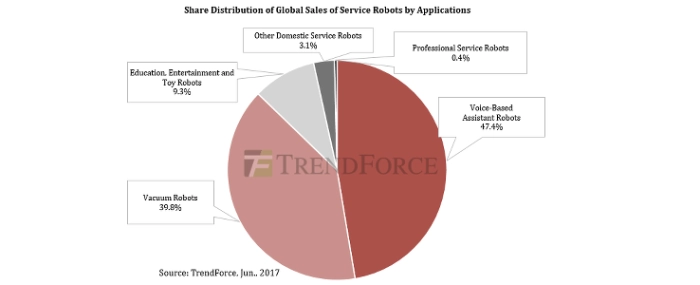
© trendforce
Analysis |
Voice-Based assistant robots popular world-wide
Rapid progress in the development artificial intelligence (AI) has allowed humans to communicate with robots using natural languages.
TrendForce’s breakdown of global sales of service robots for 2016 reveals that voice-based assistant robots accounted for the majority share of the total sales at nearly 50%. Robot vacuum cleaners made up the second-largest share of total service robot sales at nearly 40 percent. This finding and other data can be found in TrendForce’s latest report on the robotics industry.
“Voiced-based robot assistants have been on the market for many years, but sales have not really taken off until recently, when they include new functions such as remote operation of connected appliances and Internet searches,” said Harrison Po, senior manager of TrendForce’s photonic and innovative technologies research. “Due to the successes of several assistant robots, many large IT companies and technology startups have decided to enter the market with their own products.”
For example, Amazon has become a major vendor in the service robot market with its Echo speaker, which arrived on the market in 2014. Echo achieved a sales volume of around 5.2 million units for the entire 2016.
Several global brand companies across different industries have entered the service robot market. Well-known examples are Honda’s ASIMO, Softbank’s Peppers and Amazon’s Echo. Sharp, Hitachi, Toyota and LG Electronics are also developing voice-based assistant robots.
Machine learning technology will make robots more personalized for consumers
A closer look at the development of key technologies behind voice-based assistant robots finds that Amazon not only benefits from strong sales of Echo speakers but also from the adoption of Alexa by other brands selling similar hardware. LG Electronics’ Hub Robot, Ubtech’s Lynx and Lenovo’s Smart Assistant, for instance, are all running on Alexa. On the other hand, even more companies have chosen to build their voice recognition technology for their robots or work with startups such as Fuetrek, which specializes in speech recognition and UI solutions.
Po added: “Going forward, voice-based assistant robots not only have to continually improve their voice recognition capability, they also have to integrate with more powerful machine learning technologies. With better AI, these robot assistants will be able to respond appropriately according to individual users’ emotions, habits and expectations. In a sense, they will become more personalized in the future.”
For example, Toyota’s Kiro Mini, a robot that is designed to serve as a companion to the driver and passengers in a vehicle, has a conversation function consists of a voice recognition solution developed by Fuetrek and an in-house conversation engine. This conversation engine, which is design to freely interact with users without preset questions, can create responses cater to specific needs or interests.
-----
More can be found at Trendforce.
